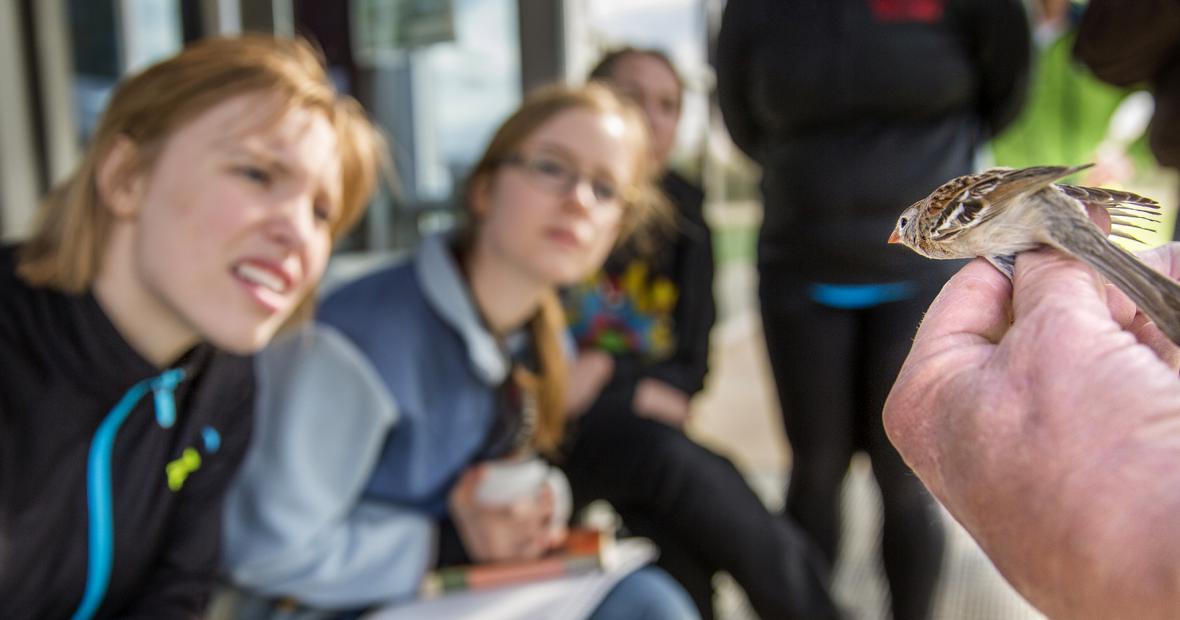Studying Birds on the Prairie
Birds captivate us through color, song, and flight. Where have they been? Where are they going? Will they return?
A partnership between Grinnell College’s Conard Environmental Research Area (CERA) and experienced bird bander Robert Van Ersvelde will help answer these questions and allow students to experience birds up close.
“It has an important educational component,” says Elizabeth Hill, manager of CERA. “There’s also something very special about holding a bird in one’s hand.”
CERA to Become Part of National Bird Banding Project
Bird banding at CERA provides students a unique way to study birds and nature across disciplines, says Hill. Hill, along with her four summer restoration assistants, is banding birds this summer at the Van Ersvelde property. The assistants have also conducted ecological restoration in prairie and savanna, assisted with citizen science workshops, and monitored bird and snake populations at CERA. They help manage Grinnell's urban prairies, too.
“It’s like the coolest thing ever,” says Sara DeRosa, intern and biology major from Eau Claire, Wis. “Bob always reminds us how lucky we are to have such an experience by asking ‘How many people got to hold a [insert bird name] today?’”
Banding is especially valuable scientifically because it can hint at climate changes that occur long before humans notice, Van Ersvelde says.
“Birds are like humans. They use a lot of the same resources we use like water and land,” Van Ersvelde says. “They’re good environmental barometers.”
“It’s a red light if a bird population suddenly decreases,” he says.
Van Ersvelde holds state and federal permits to band birds, which consists of capturing birds and placing metal bands on them for scientific research. He is also assisting Hill with obtaining permits.
At his 76-acre farm in rural Grinnell, Van Ersvelde participates in Mapping Avian Productivity Survivorship (MAPS), a program of the Institute for Bird Populations that collects data from sites across the country.
Next year, CERA plans to become a MAPS site, which would make it the only Iowa college and one of fewer than 10 colleges and universities nationwide, according to the MAPS program.
Bird Banding
The roots of bird banding go back centuries. Many cultures have marveled at the long journeys birds make — some more than 25,000 miles.
Birds are captured in 10–12-feet tall mesh nets. Researchers write down details about the birds in data sheets and use pliers to secure the metal bands that are inscribed with nine-digit serial numbers and resemble tiny bracelets.
When researchers encounter the birds again elsewhere, the data from the bands tells them about the birds’ gender, lifespan, reproductive patterns, migratory patterns, diseases, and how fast and far they travel, among other things. Today, millions of birds are banded annually.
Grinnell, CERA, and Bird Banding
CERA’s 360 acres, which contain oak savanna and prairie, provide an excellent territory for birds. Native birds include the blue jay, catbird, cardinal, rose-breasted grosbeak, and yellow-billed cuckoo. Banding takes place every 10 days through August.
Van Ersvelde has long helped local youngsters and now Grinnell College students learn about birds and nature.
“As a college student, I wasn’t lucky enough to have this opportunity to participate with bands and work with birds,” he says. “I’m hoping it will give some of the students a basis in research. I’m hoping it can open up some doors for them.”

